American Indians,
Their Headresses and Shields
|
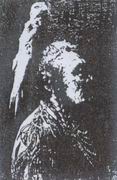
American Indian with eagle. Absaroke
(crow).
|
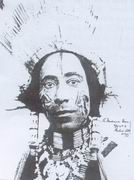
“The Medicine Man”. Louisiana, 1904.
|
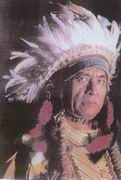
Indian leader from Mazatzal, Arizona.
|
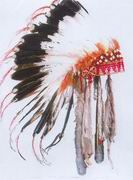
Late 19th c. Lakota headdress
(red cloth, glass beads, porcupine quills,
eagle feathers). “Such bonnets were the regalia of Plain
leaders, whose exploits were numbered in eagle
feathers.”
|
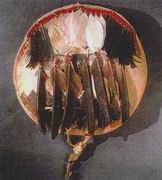
Absaroke (Crow) shield from the Northern
Plains.
Buffalo hide with feathers. New York Museum of the American Indian.
|
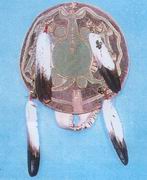
Northern Plains shield. New York Museum of
the American Indian.
|
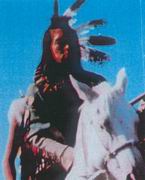
From the movie of Kevin Kostner. “Dances
with Wolves”.
|
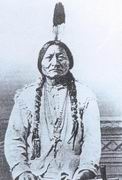
“Sitting Bull”. Dakota Indian (1885 A.D.).
|
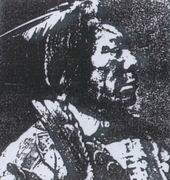
The number of feathers and the position
(in the middle of the head or on the side,
vertical or oblique, was not accidental.
|
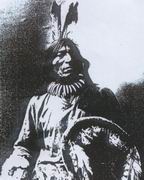
Fool Bull (1849-1911). Dakota Indian with
shield of feathers. Many will have feathers
through the nose and ear.
|

For the Indians of North
America,
when there was no more space for feathers on
the head they used to hang them on their back
and breast and shoulder.
|
|
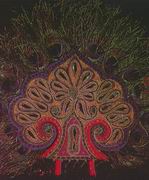
Chinese fan (1850 A.D.) made of painted
duck feathers tipped with the eyes of peacock
feathers N.M.N.H. Photo from the Smithsonian
Engagement Calendar (1978).
|
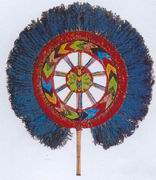
Aztec fan from about 1500 A.D. with Quetzal
feathers. Feather fans were a mark of
nobility. Vienna Museum fur Volkerkunde.
|
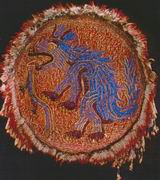
Monster made of feathers and gold on an
Aztec leather shield. Feathers are affixed to
the rim. Colors of feathers: “scarlet macaw,
blue cotinga, yellow oriole and rose spoonbill
bird.” Vienna Museum fur Volkerkunde.
|
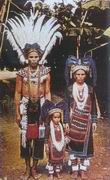
Leader of the Ami tribe of Taiwan (one of
the nine Aboriginal tribes) during the
Japanese occupation.
|
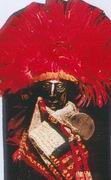
Silver figurine with parrot feathers found
near the body of an Incas child. Cuzco, Peru.
Photo: LIFE TIME books.
|
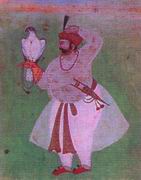
Mongol Princes used to have feathers on
the head. The eagle (like the eagle of Zeus)
was trained to kill and bring many birds.
Indian miniature (about 1600). Paris Guimet
Museum.
|

Papua of New Guinea, where the paradise
birds are at home.
|
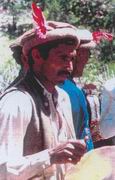
The Kalash, known as the “the descendants
of Alexander the Great” in Pakistan also have
feathers on their head.
|
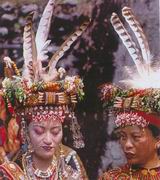
A wedding of Aboriginals of Taiwan.
|
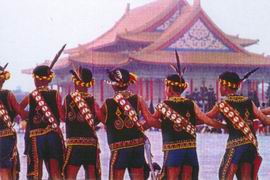
One of the nine Aboriginal tribes of
Taiwan dancing with feathers.
|
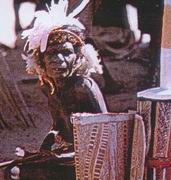
Funeral ceremony in Northern Australia.
|
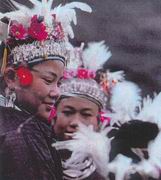
The minorities of Yao and Dong in Southern
China still decorate their head with feathers.
|
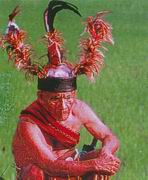
Native of the Louson island, the largest
of the Archipelago of the Phillippines in a
rice field.
The tribe of Ifugaos, men and
women, decorate the head with feathers.
|
|
Isolated elements that survived in the most
unlikely and distant corners of the Earth
helped
find the missing rings in the history of
mankind. “To bring together again the two
halves of Humanity will be the great work of
our times” (P.L. Couchoud, French Diplomat and
Historian, 1879-1959).
|
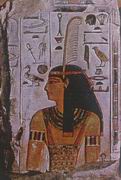
The Egyptian Goddess Maat with egret
feather. 19th dynasty relief in the
Museum at Florence.
|
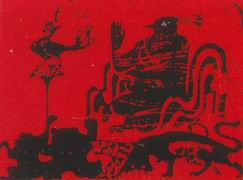
God with a bird’s face and feathers. From a
Chinese children’s book.
|
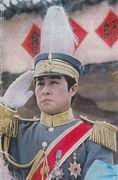
The Chinese general Cai E (1911) with
ostrich feathers on his hat. 1983 Chinese
History movie. He is riding a white horse like
the Indian of Kevin Kostner.
|
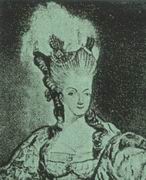
Marie Antoinette (1755-1793). Austrian
Princess and French Empress.
|
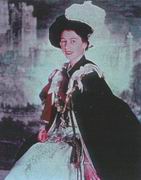 Queen Elisabeth II of England with ostrich
feathers and the Order of the Garter on the
left shoulder. Prince Charles of Wales also
has three ostrich feathers (called “the Wales
Feathers”) on his coat of arms. The first
prize for the winner of the Aboriginals of
Taiwan also consisted of three feathers.
Ostrich feathers are indispensable in the
official attire of UK sovereigns. The feather
was given as a prize maybe because feathers
were the proof that the hunter had succeeded
in killing birds to feed the people (today we
do not eat, for instance, the eagle or the
seagull but at that time any bird was edible).
To understand that the feather was given as a
prize and reward for a certain achievement
helps the expression in English “you have now
a feather in your cap”. Queen Elisabeth II of England with ostrich
feathers and the Order of the Garter on the
left shoulder. Prince Charles of Wales also
has three ostrich feathers (called “the Wales
Feathers”) on his coat of arms. The first
prize for the winner of the Aboriginals of
Taiwan also consisted of three feathers.
Ostrich feathers are indispensable in the
official attire of UK sovereigns. The feather
was given as a prize maybe because feathers
were the proof that the hunter had succeeded
in killing birds to feed the people (today we
do not eat, for instance, the eagle or the
seagull but at that time any bird was edible).
To understand that the feather was given as a
prize and reward for a certain achievement
helps the expression in English “you have now
a feather in your cap”.
|
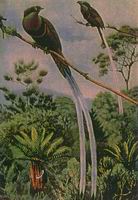
Paradise birds of New Guinea. They live at
a height of 5,000 ft. The tail of the male
bird is twice as long as its body
|
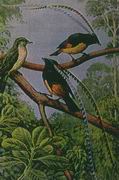
One female and two male Paradise birds, one of
fifteen species of Paradise birds of New Guinea
and the only one that has the long feathers
growing from its head and not from its tail.
Probably this bird about which not much is known
gave the idea to decorate the head with feathers.
Strong sexual dimorphism is the characteristic of
the Paradise bird and the female has neither the
beautiful colors nor the long feather of the male. |
|
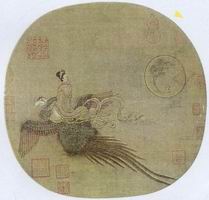
Goddess on phoenix bird.12th c.
painting on silk in the Museum of History at
Beijing. |
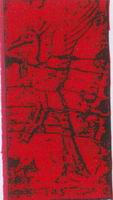
“Supernatural bird” (probably a phoenix) from
Palaikastron, in Crete. Ivory plaque (LMI). |
|
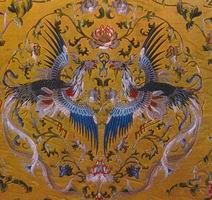
Phoenix birds embroidered on the back of a
Qing dynasty imperial chair. Collection of the Summer Palace of Chengde. |
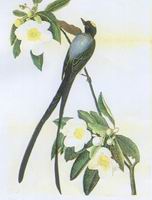
Forked-tail male flycatcher. Chromolithograph
(c. 1860) N.M.H.T. |
|
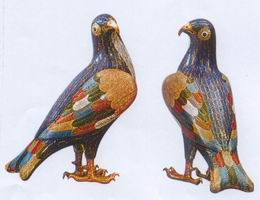
Cloisonne parrots made (1871) in the imperial
workshop. N.M.N.H. |
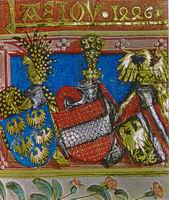
The coats of arms of Austria decorated with
birds and feathers. From the “handregister” of the
Emperor Frederick III (1446). Vienna Staatsarchiv. |
|
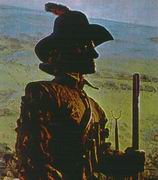
Austrian imperial musketeer. Oil on canvas,
about 1640. Vienna Heeresgeschichtliches Museum.
The hat of the national costume of Austria, today,
is decorated with feathers and woodcock feathers
have the Scotch on their hat. |
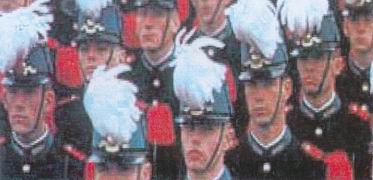
French cadets of the military school St. Cyr
in dress uniform. The cadets of the military
school Saint Cyr north of Paris have on their hats
cascar bird feathers (a kind of ostrich from
Malaysia). Eagle feathers have the Italian Alpini
and pheasant feathers decorate the hats of Tyrol. |
|
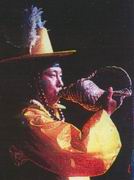
Korean
warrior during a ceremony with feathers on his hat.
|
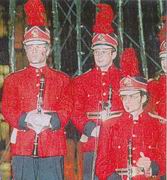
Philharmonic orchestra of the Athens
Municipality. Red feathers and red or blue
jackets. |
Africa and Shaka Zulu
It was easy for Shaka
Zulu and the colored people of Africa to find
feathers for their headdresses. |
|
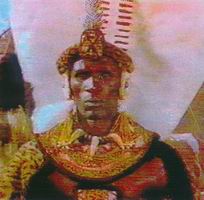
Shaka with one feather on his head... |
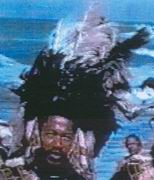
....and his
“prime minister” with his head full of feathers. |
|
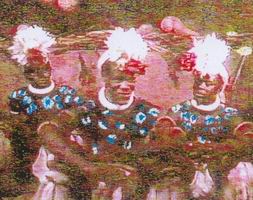
Warriors of Shaka Zulu with feathers on their
head and blue paint on their breast for
protection. |
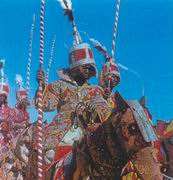
National Day of Nigeria. Horsemen, that look
medieval, wear helmets decorated with feathers. |
|
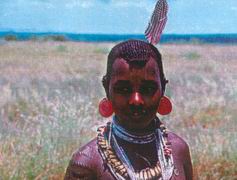
Karo woman of
Ethiopia.
|
Return
to Feathers Page 1
Return
to Theresa Mitsopoulou Index Page
|




























 Queen Elisabeth II of England with ostrich
feathers and the Order of the Garter on the
left shoulder. Prince Charles of Wales also
has three ostrich feathers (called “the Wales
Feathers”) on his coat of arms. The first
prize for the winner of the Aboriginals of
Taiwan also consisted of three feathers.
Ostrich feathers are indispensable in the
official attire of UK sovereigns. The feather
was given as a prize maybe because feathers
were the proof that the hunter had succeeded
in killing birds to feed the people (today we
do not eat, for instance, the eagle or the
seagull but at that time any bird was edible).
To understand that the feather was given as a
prize and reward for a certain achievement
helps the expression in English “you have now
a feather in your cap”.
Queen Elisabeth II of England with ostrich
feathers and the Order of the Garter on the
left shoulder. Prince Charles of Wales also
has three ostrich feathers (called “the Wales
Feathers”) on his coat of arms. The first
prize for the winner of the Aboriginals of
Taiwan also consisted of three feathers.
Ostrich feathers are indispensable in the
official attire of UK sovereigns. The feather
was given as a prize maybe because feathers
were the proof that the hunter had succeeded
in killing birds to feed the people (today we
do not eat, for instance, the eagle or the
seagull but at that time any bird was edible).
To understand that the feather was given as a
prize and reward for a certain achievement
helps the expression in English “you have now
a feather in your cap”.
















